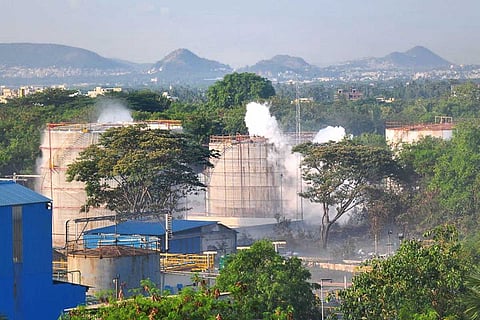

“An estimated 800 tonnes of styrene escaped into the surroundings” in the LG Polymers gas leak incident of 07.05.2020 in Vizag, Andhra Pradesh, according to a report on 28.05.2020 by the committee headed by Justice (Retd) Seshasayana Reddy constituted by the Principal bench of the National Green Tribunal in New Delhi. That is more than 40 percent of the total styrene stored in the offending M6 tank. The report has recommended special measures such as long-term health monitoring of the surrounding communities as styrene is genotoxic and “can cause carcinogenic health impacts to the population exposed...”
Twelve people and 22 animals died, and 3000 people were exposed to toxic Styrene gas in the Vizag tragedy, according to figures reported by the Committee. The report finds fault with the Department of Industries, Factories and Boilers for safety lapses, and with the Visakhapatnam Urban Development Authority (VUDA) for approving residential layouts in close proximity with the hazardous factory.
Here’s what the Committee’s report says about how the leak happened, and the safety lapses that led to the disaster and the subsequent inability to contain it.
Styrene, a reactive chemical, that is used to manufacture polystyrene should preferably be stored at less than ambient temperature, preferably at 15 to 18 degree celsius to ensure that it does not polymerise. The process of polymerisation where monomers of styrene combine with each other to form larger chains is exothermic – i.e. the process generates heat. As temperature increases, the rate of polymerisation too increases. Unless this is contained by slowing down or arresting the polymerisation, the process can go out of control leading to dangerous increases in temperature and pressure.
To keep styrene under control, inhibitor chemicals such as Tertiary Butyl Catechol need to be added even as temperatures of the stored styrene are maintained below 25 degree Celsius. TBC loses its inhibiting properties at higher temperatures. At the LG Polymers plant, a series of safety lapses and technological shortcomings led to a condition where TBC concentrations were insufficient to inhibit polymerisation. Inadequate cooling and the heat build-up during the COVID-19 lockdown period due to gradual polymerisation then led to a runaway reaction. This increased temperatures and pressures to disastrous levels causing the Styrene gas to escape through the safety valve located at the top of the tank.
The Committee ominously notes that the disaster would have been far worse had the safety valve failed.
The Committee’s report notes several flagrant lapses or under-designed features that contributed to the disaster and made effective mitigation difficult. Below are observations by the Committee with brief explanations of their implications added by the author:
1. The M6 styrene storage tank was of an old design.
2. The 12 metre high tank had no meters for measuring temperature and pressure at the top of the tank, which is where pressure and temperature build-up are likely to be first evident. The tank had only one temperature monitor that was located at the bottom of the tank near the refrigeration unit.
3. The tank did not have an interlock system that would trigger the refrigeration unit when temperature increase is detected. Having such an arrangement would have forced the system to increase cooling/chilling action and retard the reaction upon detection of a temperature increase.
4. There was no arrangement for an external water spray to contain the leak from the safety valve. Neither was there any arrangement for unmanned hose management. This hampered mitigation efforts as people were unable to wield a hose anywhere near the tank due to the toxic gas clouds.
5. The public siren system could not be activated as it was a manual system, and located in an area rendered inaccessible by the vapour cloud.
6. Chillers (coolers) serving the M6 tank were turned off at 5 pm the earlier evening as per routine site practice as ambient night temperature required little or no chilling.
7. As vapour loss was not anticipated, there was no provision for an automated sprinkler to neutralise the vapour.
8. TBC, the inhibitor chemical, was not added to the tank after April 1 as there was no stock of this chemical on site. Without adequate TBC, styrene will gradually polymerise, release heat, polymerise faster in the hotter medium and eventually build up to a runaway reaction.
The spill was so massive that even 24 hours after the gas leak, on 08.05.2020, levels of styrene in ambient air in Venkatapuram – the worst affected village – were 374 parts per million, according to data recorded by Andhra Pradesh Pollution Control Board. According to the US Environmental Protection Agency, exposures to levels of 340 ppm over 4 to 8 hours can prove lethal.
Nityanand Jayaraman is a Chennai-based writer and social activist.